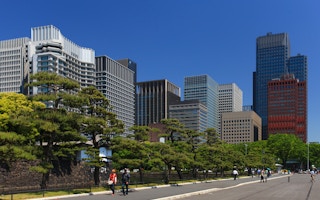The city-wide Tokyo Cap and Trade Program has stimulated energy efficiency in the commercial and industrial sector so effectively it has achieved double its emissions reduction goal across the 1300 properties covered, according to a recent research report.
The commercial office sector outperformed all others, achieving a reduction of emissions intensity of 27 per cent by financial year 2013, compared to the year 2000 baseline. The target had been set at eight per cent by FY 2015, and 20 per cent by 2020.
The second phase of the TCTP is still expected to see emissions reduce even further, with more emphasis on buildings using low-carbon energy sources included in the accounting.
Tokyo Metropolitan Governor Yoichi Masuzoe told the British Chamber of Commerce in Japan, during a speech in March this year, that the plan was to make Tokyo a “Smart Energy City”, increasing the share of renewables to 30 per cent by 2030.
The energy use and carbon emissions reductions have been achieved to date almost entirely through building owners and managers engaging with the “cap” part of the equation, rather than through active emissions trading, with few participants actually buying or selling carbon credits earned under the scheme.
The Alternative building emission-reduction measure: outcomes from the Tokyo Cap-and-Trade Program report by Yuko Nishida, Ying Hua and Naomi Okamoto said the ETS had “not been heavily utilised”. Only 112 cases of trading were recorded between the TCTP’s commencement in 2010 and March 2016.
“
The certification system is very demanding with more than 100 items to be checked and verified to prove the highest level of equipment and performance. Certified facilities are allowed reduced compliance factors of 50 per cent and 75 per cent (for top-level and near-top level facilities, respectively) of the reduction obligation.
Yuko Nishida, Ying Hua and Naomi Okamoto, researchers, Tokyo Cap-and-Trade Program
“Instead, another scheme unique to TCTP has been working well. The Top Level Facility Certification system [hereafter TOP system] was introduced through the stakeholder negotiation process to appreciate very high performance facilities, and enables leading developers to gain a reputation and advantages in the property (real estate) market,” the report said.
“The certification system is very demanding with more than 100 items to be checked and verified to prove the highest level of equipment and performance. Certified facilities are allowed reduced compliance factors of 50 per cent and 75 per cent (for top-level and near-top level facilities, respectively) of the reduction obligation.”
By the end of the 2014 financial year, 87 facilities were certified as top level or near-top-level. The Tokyo Metropolitan Government published details of these facilities and their performance, both in recognition of their achievements and to spread the word on the technologies adopted and actions taken to reduce energy use.
Some of the trends the report noted include the virtual disappearance of any form of lighting other than LEDs post-2011. Likewise, upgrades to mechanical systems have seen turbo chillers increasingly displace absorption chillers for heating, ventilation and airconditioning systems.
“Along with the measures with investment, operational measures without financial cost or with minimum cost deserve great attention. Some operational measures, including optimisation of AC starting time, relaxing light-level standards and cooling with outdoor air, can be found. The accumulated reductions estimated here are not as high as those from measures with investments. However, operational measures are a collection of small actions with promising cost-effectiveness,” the report said.
The TCTP also required facility owners to establish an organisation or network within their buildings to promote energy efficiency, and to designate leaders for promoting energy efficiency, one a representative of the facility owner (usually a facility manager) and another an engineering representative. Regular meetings also had to be held with tenants to promote energy efficiency actions.
“The reason to set such requirements in the TCTP ordinance came from the lessons learned from the experiences of the prior reporting programme that a human network with a clear target is crucial for pursuing comprehensive energy efficiency improvements,” the report said.
One of the conclusions the authors have drawn is that enforceable cap and trade schemes like the TCMP may be more effective than building codes for facilitating major energy-use reductions and emissions reductions.
“TCTP is categorised as a target-setting type of regulation that allows facility owners/managers to decide their best approach to achieve the target. Conventional regulations are prescriptive, represented by building energy codes. Compared with such regulations, TCTP has several unique features and may be a prototype cap-and-trade scheme, though it is currently the only program that covers buildings and includes buildings’ entire energy consumption.”
The authors said that as an “alternative governance approach” TCTP can cope with the major challenges of existing regulations, including:
- It targets existing buildings
- It directly mandates a specific level of emissions reductions instead of regulating design specifications
- Facility operations and control are appreciated as crucial for energy savings, enhancing the value and roles of facility managers and engineers
- It is cost effective for owners and managers of assets as they can plan reduction measures in tandem with business planning goals and facility updates schedules
Read the full report.
This article was published with permission from The Fifth Estate.










